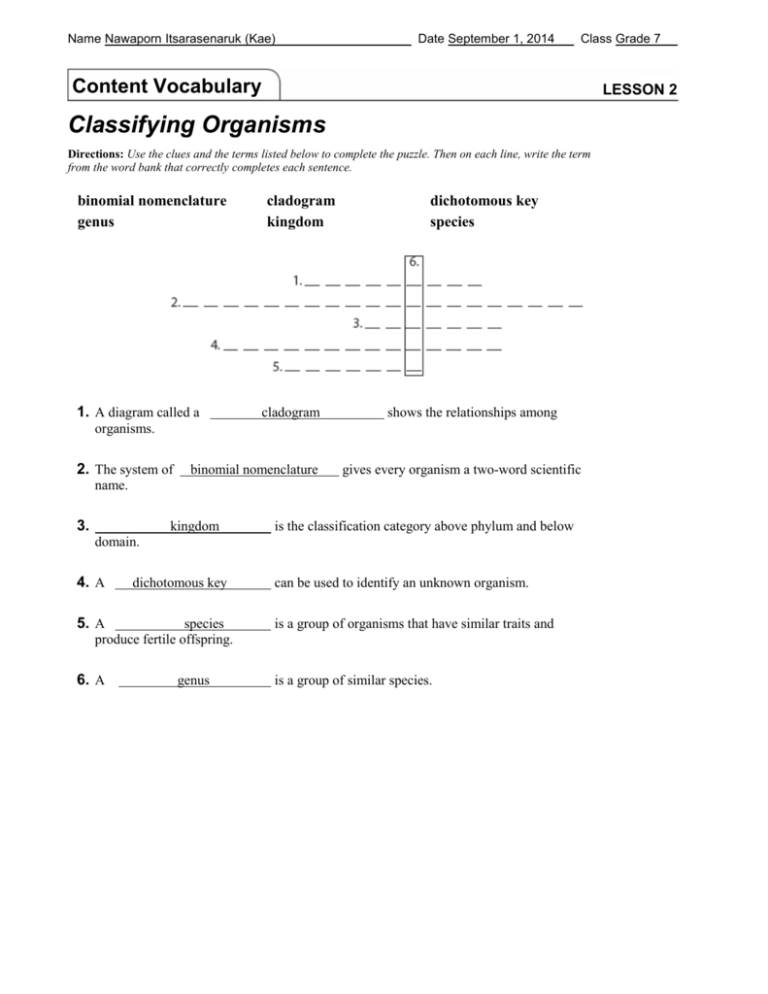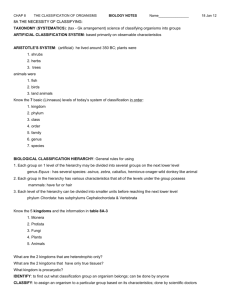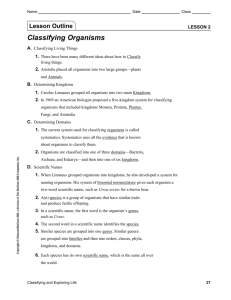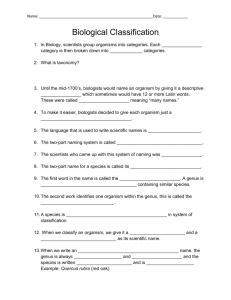Lesson 2 | Classifying Organisms
advertisement

Name Nawaporn Itsarasenaruk (Kae) Date September 1, 2014 Class Grade 7 Content Vocabulary LESSON 2 Classifying Organisms Directions: Use the clues and the terms listed below to complete the puzzle. Then on each line, write the term from the word bank that correctly completes each sentence. binomial nomenclature genus 1. A diagram called a cladogram kingdom cladogram dichotomous key species shows the relationships among organisms. 2. The system of binomial nomenclature gives every organism a two-word scientific name. 3. kingdom is the classification category above phylum and below domain. 4. A dichotomous key 5. A species produce fertile offspring. 6. A genus can be used to identify an unknown organism. is a group of organisms that have similar traits and is a group of similar species. Name Date Class Lesson Outline LESSON 2 Classifying Organisms A. Classifying Living Things 1. There have been many different ideas about how to classify living things. 2. Aristotle placed all organisms into two large groups—plants and animal . B. Determining Kingdoms 1. Carolus Linnaeus grouped all organisms into two main groups called kingdom . 2. In 1969 an American biologist proposed a five-kingdom system for classifying organisms that included kingdoms Monera, Protista, Plantae , Fungi, and Animalia. C. Determining Domains 1. The current system used for classifying systematics systematics. Systematics uses all the is called evidence that is known about organisms to classify them. 2. Organisms are classified into one of three —Bacteria, domains Archaea, and Eukarya—and then into one of six kingdoms . D. Scientific Names 1. When Linnaeus grouped organisms into kingdoms, he also developed a system for naming organisms. His system of binomial nomenclature gives each organism a two-word scientific name, such as Ursus arctos for a brown bear. 2. A(n) species and produce fertile offspring. is a group of organisms that have similar traits 3. In a scientific name, the first word is the organism’s genus , such as Ursus. 4. The second word in a scientific name identifies the organism’s appearance 5. Similar species are grouped into one . Similar genera are grouped into genus families . and then into orders, classes, phyla, kingdoms, and domains. 6. Each species has its own the world. specific name , which is the same all over Name Date Lesson Outline continued E. Classification Tools 1. A(n) dichotomous key is a series of descriptions arranged in pairs that can be used to identify an unknown organism. The chosen description leads to another pair of descriptions or to the identification of the organism . 2. A(n) cladogram is a branched diagram that shows the relationships among organisms. New characteristics appear before each branches . Class Name Date Class MiniLab LESSON 2: 20 minutes How would you name an unknown organism? Assign scientific names to four unknown alien organisms from a newly discovered planet. Procedure 1. Use the table to assign scientific names to identify each alien. 2. Compare your names with those of your classmates. 1. Diocularus rectanguliformus 2.trianguliformus monantenna 3.diocularus triangulusformus 4. Monuris rectanguliformus Prefix Meaning Suffix Meaning mon– one –antennius antenna di– two –ocularus eye rectanguli– square –formus shape trianguli– triangle –uris tail Analyze and Conclude 1. Explain why you chose the two-word names for each organism. I chose two-word name for each organism, because the name will show the how the animal looks like. And it will chow exactly how animal look like. 2. Compare your names to those of a classmate. Explain any differences. Some of the animals name have the same as my classmate, but some of them just change the position of the name. 3. Key Concept Discuss how two-word scientific names help scientists identify and organize living things. The two-word scientific name help scientists organize the name the animal easily and clearly. So the scientist can easily classify the groups of living things.









